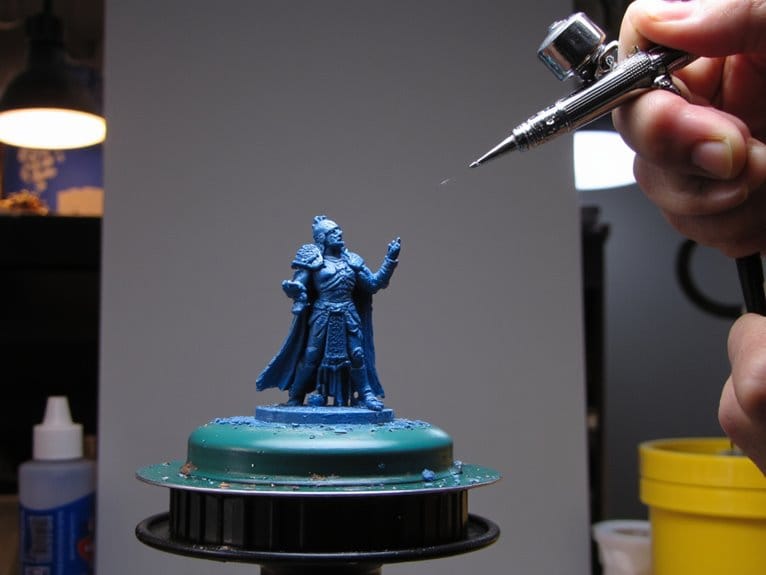We are supported by our audience. When you purchase through links on our site, we may earn an affiliate commission, at no extra cost for you. Learn more. Last update on 3rd July 2025 / Images from Amazon Product Advertising API.
Mastering layering in miniature painting involves skillfully applying thin, transparent coats that blend seamlessly to enhance depth, vibrancy, and realism in each stroke. By diluting paint with water and focusing on smooth shifts between colors, a rich and detailed finish can be achieved, adding complexity to the miniature. Controlled brush strokes play a vital role in creating precise layers, ensuring a visually compelling outcome. Understanding these techniques is key to elevating your miniature painting skills.
Layering Technique Basics
Exploring the fundamental principles of layering technique in miniature painting, we investigate the intricacies of applying thin, transparent layers to achieve nuanced highlights and shadows. The key to mastering this technique lies in the controlled application of thinned paint, creating a smooth and semi-opaque finish. By diluting the paint with water in a 1:1 ratio, each layer can be delicately built up, ensuring a seamless shift between colors.
When working with layers, it is essential to understand that each successive layer should cover a smaller area than the previous one, gradually increasing the lightness of the shade to create a gradient effect. This meticulous process is pivotal for achieving realistic results in miniature painting. Following the guidance of experts like Angel Giraldez, painters can learn to navigate the complexities of layering with precision and finesse.
In the layering process, the initial layers serve as the foundation, establishing the base colors and overall tonal values. Subsequent layers are then applied, each adding depth and dimension to the miniature. Final highlights are strategically placed to enhance specific features, bringing the miniature to life. Blending techniques play an important role in seamlessly merging the layers, ensuring a cohesive and polished final appearance. Mastering the art of layering is a fundamental skill for any miniature painter, allowing for the creation of stunning and detailed works of art.
Importance of Thin Layers
Thinning paint with water is an essential technique in miniature painting to achieve precise and realistic results through the controlled application of thin layers. When applying thin layers, it allows for a smooth coat, ensuring the paint is evenly distributed without clumping or obscuring fine details on the miniature. This method also prevents overloading the miniature with paint, which can compromise the intricacies of the sculpt and lead to a less refined finish.
Moreover, thin layers enable smooth shifts between colors, essential for creating depth and dimension in miniature painting. By gradually building up the layers with diluted paint, it becomes easier to blend different hues together, achieving realistic highlights and shadows. This controlled approach to layering not only enhances the visual appeal of the miniature but also facilitates the creation of subtle color variations and textures.
In essence, the importance of thin layers in miniature painting cannot be overstated. They serve as the foundation for achieving a high level of detail and precision in the final artwork, allowing for better color control and smooth shifts between layers. Mastering the technique of applying thin layers with water is fundamental to elevating the quality and realism of miniature paintings.
Achieving Smooth Transitions
To seamlessly blend colors on miniatures and enhance realism, applying thin and transparent layers of paint is pivotal for achieving smooth shifts in layering. When aiming for smooth changes between different shades on a miniature, it is vital to gradually build up color intensity through multiple layers of thinned paint. Properly thinned paint with a specific ratio, such as a 1:1 ratio of paint to water, plays a key role in achieving these smooth changes. This ratio guarantees that the paint flows smoothly and allows for better control over the blending process.
When layering paint to achieve smooth changes, it is important to pay attention to the deepest recesses of the miniature. By strategically applying thin layers of paint to these areas, you can create a sense of depth and enhance the overall realism of the piece. Consistent brush control and practice with layering techniques are essential for mastering smooth changes in miniature painting. By honing these skills and understanding the importance of proper thinning ratios, you can elevate the quality of your work and create stunning color changes on your miniatures.
Enhancing Color Intensity
Enhancing color intensity in miniature painting involves strategically layering thin coats of paint to gradually build up depth and richness, resulting in a visually appealing finish. By adding layers of paint, the colors become more vibrant and enchanting, enhancing the overall look of the miniature. Thinning the paint is essential for achieving a smooth application and seamless shifts between different shades and highlights.
- Layering Technique: The key to intensifying color is the systematic application of multiple layers, allowing each one to dry before adding the next. This gradual buildup creates a sense of depth and complexity in the colors.
- Lighter Color Base: Starting with a lighter color as the base layer helps in enhancing the brightness and intensity of the subsequent layers. This base provides a foundation for the colors to stand out more vividly.
Through the careful application of lighter colors and strategic layering techniques, miniatures can achieve a lifelike appearance with rich, intense colors. Mastering the art of enhancing color intensity through layers of paint is vital for creating stunning miniature artworks that catch the eye and mesmerize the viewer.
Controlled Brush Strokes
I will focus on brush stroke precision and mastering layering techniques in miniature painting. Controlled brush strokes play a critical role in achieving smooth color changes and precise application. The consistent pressure applied determines the amount of paint on the miniature, requiring practice and patience for best results.
Brush Stroke Precision
Achieving precise layering in miniature painting hinges on mastering controlled brush strokes, requiring a steady hand, consistent pressure, and meticulous attention to detail. To achieve brush stroke precision, focus on the following key points:
- Maintain a steady hand and apply consistent pressure for smooth and even layers.
- Pay attention to the direction and angle of your brush strokes to control blending.
- Practice regularly to develop the dexterity needed for intricate details.
- Utilize the tip or edge of the brush for precise paint application in delicate areas.
Layering Technique Mastery
Mastering the layering technique in miniature painting demands adept control over brush strokes to ensure precise and flawless application of colors and highlights on a miniature canvas. Controlled brush strokes are the foundation of achieving smooth shifts and maintaining paint coverage consistency. By honing precision and consistency in brush movements, artists can accurately layer colors and highlights on miniatures, resulting in professional-looking results. The key lies in practicing to maintain a steady hand and applying even pressure on the brush throughout the process. Developing mastery over controlled brush strokes not only enhances the overall quality but also elevates the level of detail achievable through the layering technique in miniature painting.
Layering for Realistic Effects
Layering in miniature painting is a fundamental technique essential for achieving realistic effects through the gradual application of thin, transparent paint layers. When aiming for lifelike results, the layering process plays a critical role in creating depth and visual interest in miniatures. Here are some key points to keep in mind when using layering for realistic effects:
- Shading and Highlights: Layering allows for the precise application of shadows and highlights, enhancing the three-dimensional appearance of the miniature.
- Color Blending: Through careful layering, smooth color blending can be achieved, giving the illusion of seamless blending and subtle tonal shifts.
- Depth and Dimension: Building up layers of paint gradually adds richness and complexity to the miniature, making it visually compelling and realistic.
- Gradient Effect: Each layer covering a smaller area with a lighter shade contributes to a gradient effect, which is essential for creating a natural-looking finish.

